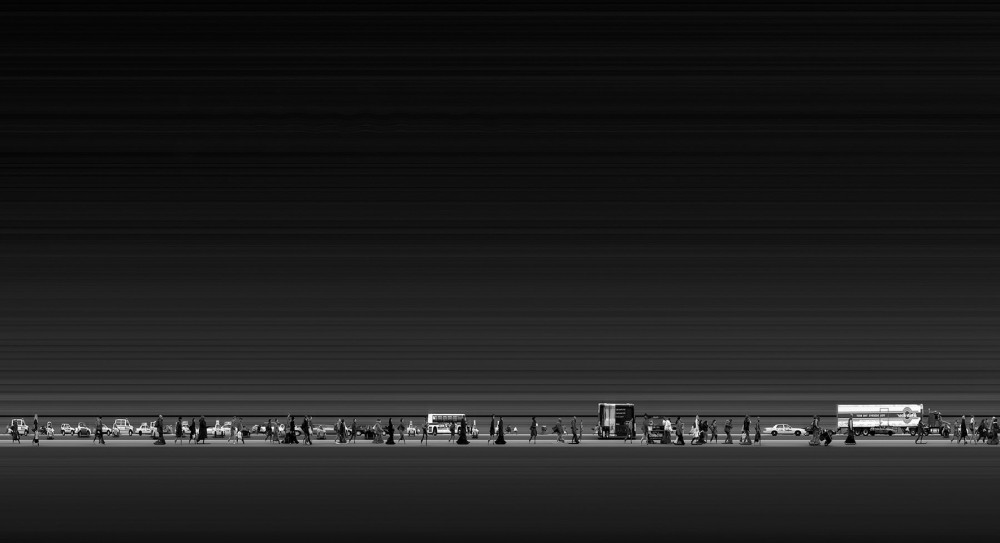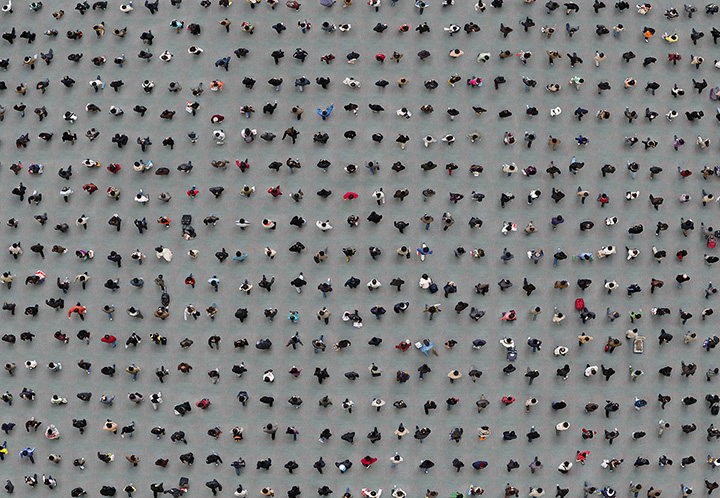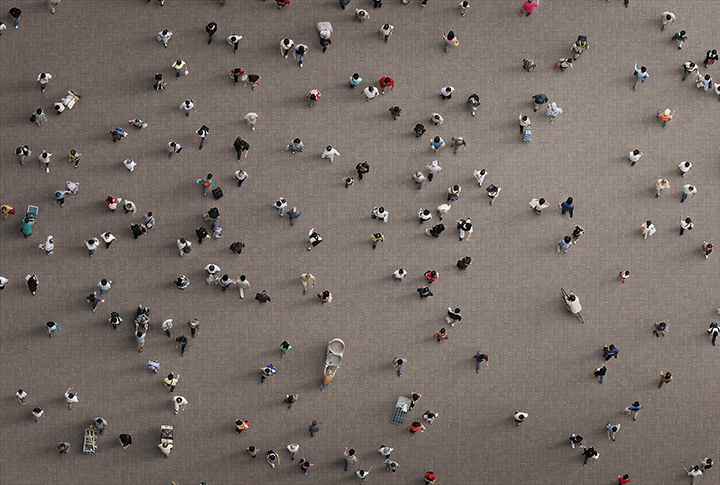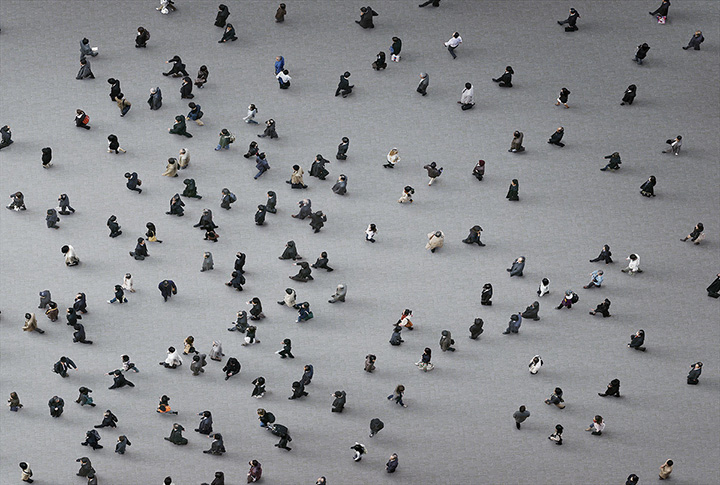Image above: Portrait by Andrea Blanch.
ANDREA BLANCH: Our issue is about ritual; and I think your series Urban Flow pertains to ritual. Are you still working on it?
ADAM MAGYAR: No. I completed that in 2008. I plan to add a few more images this year around November in New York, but otherwise the series is done.
AB: How did it come to be?
AM: Well, I was in a collection of street photography before, and it didn’t please me. Something was missing because I wanted to talk about existence and our transiency, but those photos were misguided in a way. People didn’t think about being. They thought about characters and life situations. But I liked street photography, and I think I am still a street photographer. I’m just experimenting with doing it in a different way. I had a few years when I was struggling with myself about how to step out of the conventional way of capturing this kind of nothingness, because the street is pretty empty. If you are not focusing on characters or events on the street, then it’s just about getting from one point to another. It’s wasting time; nothing really happens. It’s eventless. All my situations capturing are eventless. I wanted to depict being. So the images have to be a particular distance from nothingness. I tried to do something that is very real and deep, and a bit depressing as well. “Urban Flow” is not a good pressing. I think the later works became a bit darker. They are getting darker and darker. I guess my newest video “Array” is darker than the “Stainless” videos.
 ©Adam Magyar, Urban Flow #1364, London, 2008, 10 x 94 1/2” pigment print. Courtesy of Julie Saul Gallery, New York.
©Adam Magyar, Urban Flow #1364, London, 2008, 10 x 94 1/2” pigment print. Courtesy of Julie Saul Gallery, New York.
AB: Are you talking about the videos?
AM: Yes, I was working on the “Stainless” video in parallel. It’s kind of the same thing. But in terms of playing with individual people, the method is obviously very different. “Stainless” doesn’t have as many layers as the others.
AB: How did you do your street photography? What you’ve done with this Stainless series is very tech. How long did it take to develop this series in a way that you have become proficient in it? How did you decide that that was the technique?
AM: I never work unaware. I have a technique, and I start experimenting with that. I know what I want to see and feel when I look at the image. I am looking for the possibilities in that.
AB: How did you get to it?
AM: “Stainless” came from “Urban Flows”. I used the same technique in a way. However the camera that I put together for “Urban Flows” was not good or fast enough for capturing trains, because trains are fast. I wanted to capture more data than that camera could capture. So the new camera works on the same principal. It is an industrial camera that is used for quality checking.
AB: Do you do a lot of pre and post-production?
AM: Yes, it always takes time especially the pre-production because I have to put the system together. So I usually work on a series for two years.
AB: What do you mean by “putting the system together”?
AM: For “Urban Flow” I made the camera and the shutter that controls the camera.
AB: Is there anything on the market that does what you want it to do?
AM: There are photo-finish cameras that do the same thing, but they are not really accessible. The cameras that I use are not the cameras you can buy in a shop. You have to find a factory or the manufacturer. Because these cameras are made for industrial use, they have a different way of marketing them than they would other brands. I always have to make research to find the right one, or I have to find the company who is willing to give me a camera or support. It’s like the “Stainless” video, which is supported by this German factory.
 ©Adam Magyar, squares Shanghai #517. In Courtesy of Julie Saul Gallery, New York.
©Adam Magyar, squares Shanghai #517. In Courtesy of Julie Saul Gallery, New York.
AB: Do you make the camera?
AM: No, they make the camera (to my specifications). For the photo series I used a line-scan camera. These are machine vision cameras, but they are usually for specific industrial or scientific purposes. Depending on the task, they have to develop the system behind the camera. They develop software that does the specific tasks for the quality, so they are not really complete systems. They are like censors in a way and the users have to develop the systems behind it. So that’s what I do. I put together my system for using the camera as a photographic camera instead of the usual way. So basically I control what I see and how I can compose, and I set up the values that look like any other camera in a way.
AB: I don’t understand how those cameras work.
AM: It always depends on the user interface in a way. If you have a commercial camera, you have a user interface. You have your buttons and functions that they make for photographers. However these devices I use are kind of blank in a way. There is no button, as software controls everything. The user develops the software. They actually have readymade software, but it is for scientific or industrial purposes. So it’s not convenient for me to use it.
AB: So you have all that pre-production. What about post-production?
AM: It depends on the series. In “Urban Flow”, I didn’t have to do much post-production because I wanted it pretty much as it is. It is only the printing, the craft and the framing, which I always take care of. As for the other ones, I have to work more, because there are always quality issues due to the low light and the high noise. It happens in both the videos and photos, as well the train photos. I have to write a little software to correct those problems. It could take a few days or a few months.
AB: How did you become so smart about technology?
AM: I’m not very smart. I’m just patient and really obsessed by what I want to achieve. So I just don’t sleep.
AB: In the process of producing Urban Flow, do you have to research to find a camera?
AM: Not for Urban Flow. Yes, I did some research, but I realized it was not very accessible. That was my first series and I didn’t know what I could expect. So I just bought a scanner for $50, took it apart and built a camera from it. That’s it. So it was not a very big investment. I just had to work on the software for a few months to make it work well. Then I made a test on a train in New York. I really liked the result but not the quality. That’s why I had to start working on a new system that was able to capture the train with all those details and in that size.
 ©Adam Magyar, squares Hong Kong. In Courtesy of Julie Saul Gallery, New York.
©Adam Magyar, squares Hong Kong. In Courtesy of Julie Saul Gallery, New York.
AB: What came first, your interest in photography or your interest in engineering and programming?
AM: I was interested in digital tech and programming when I was around 20. I started taking photos when I was 30 almost. Before being a photographer, I was actually traveling. I was doing graphic design for a living, but in that decade I was traveling a lot. I spent a lot of time in India, and that is where I started to take photos because I was not very talkative. I had some experiences that I wanted to share some way. Then it came out. Photography just happened. I got a book in an elementary school for doing something good and it was about photography basics. So I had that book with me in India, and I started to read about “Aperture” and all sorts of things. But it came quite late because it was in 2000 when I was 28.
AB: How long did you stay with traditional photography before you began these new series now?
AM: I started the show in 2006.
AB: When does it become apparent that the photographic technology will not suffice? Does it come from testing or did you know it before?
AM: That’s the first thing that I knew. But now it’s more about the art of my process. I’m not even looking for anything that I can’t get. But I think it’s going to happen that I will grab a commercial camera one day. It has to come.
AB: What is it about people in motion that captivates you?
AM: It’s about how we are passing by here, transient passengers. I’ve been afraid of time since I was 24. I’m always on the move, always. So not only people are moving, my images are moving. I’m kind of capturing what I see, because I traveled a lot. I spent a lot of time in observation, sitting and watching people passing by. Or I was passed by them and basically that’s how I see the world.
AB: Are you more into time, or the actual motion?
AM: I never really think about motion. But time, yes, because I’m living that pretty much. Although time does not really exist, it’s a human creation. Changes and motion do exist but they don’t really think about the present. That’s what this technique actually represents, which is basically this really incomprehensible moment. So all my works are actually motion capturing, They are all components of little moments. It’s like long exposure photography, but it does not happen on the whole field. It just happens on a portion of the work. So you see those fragments of life one after another on one image. This can be a moving one or a still photograph. It’s relentlessly going on.
 ©Adam Magyar, squares Tokyo. In Courtesy of Julie Saul Gallery, New York.
©Adam Magyar, squares Tokyo. In Courtesy of Julie Saul Gallery, New York.
AB: Do you ever think that you create a lot of work for yourself because there might be ways of capturing without having to make a camera?
AM: Yes, definitely. You can approach this theme in different ways. At some point all photographers are doing this because that’s what it’s about. That’s the real magic of photography. The light reflecting back from subjects goes through the lenses and manifests in an image. That is the magic of photography. It’s always based on something that happened. So in terms of that, I’m just a regular photographer.
AB: Maybe that’s why you think about using a real camera again?
AM: It’s a different challenge.
AB: Do you feel your images speak specifically to urban life in the modern world or do they have a universal timeless quality?
AM: I hope to have the second. I don’t really talk about city life. I’m just working in cities because they are inspiring me. I like to get lost and to feel small. That inspires me. So urban spaces are the ultimate human spaces because we created them. Everything that you see here, that’s us. I’m interested in the human existence. That’s why I work in cities. Otherwise I don’t really see too much of that in my images. Or it’s not very important to me. You rarely see any interaction on my photos. Everyone is pretty much alone. I don’t always capture crowds. I work specifically in those situations where people are alone, like in the videos. I normally made them in the morning on weekdays when people go to work. Normally people go to work alone. That’s something that I am kind of interested in capturing. We are all living together, working in this world together and making it together. We are part of the system of little gears, but we don’t have to have too much to do with each other. We have very few connections compared to how complicated this society and the whole global world now is.
AB: Do you live in Prague?
AM: No, I live in Berlin.
AB: Is that busy?
AM: Not really. Sometimes it’s hard to believe. It’s the capital of Germany. Actually it’s pretty quiet and peaceful. Berlin does not want to kill you. It’s definitely a very gentle place. You don’t have that kind of pressure that you might have somewhere if you are not super successful, like in New York or Paris where you have to be really established. That’s why Berlin attracts young artists. I have a funny connection with Berlin in that I nearly don’t actually have one. That means I am doing my pre and post works on my computer all the time. When I leave my apartment, I usually fly.
AB: Are you ok with that?
AM: That is my life. Yes, this is how it is. I like my life. I don’t leave because I’m okay with that and it’s more important to me than going to the city and doing whatever.
AB: Do you think of yourself as an artist, a photographer, or a photo artist?
AM: I like to say that I am a photographer. But I am motion capturing anyway. I just don’t want to say I’m a video artist. In terms of titles, I think I’m not doing any applied photography.
AB: You are finishing this next project and your exhibition in February for Julie Saul Gallery, what is that going to be?
AM: Most likely I am going to present some of my new video series entitled “Array”.
AB: Does it have a meaning?
AM: Yes. It’s like this is an array, a table itself. It can be 3D or 2D.
AB: What is your daily ritual?
AM: It depends on the year, the section of my year and what I’m doing. If I’m at home, I wake up sitting in front of screens; I have about six or seven on my table and I start doing my tasks. They are not only about my images; I have to work more and more on my job as an artist. Most of my time is about dealing with the logistic sort of thing and printing. I finish at some point usually four or five o’clock in the morning. Then I go to bed.
AB: What if you are traveling?
AM: That’s kind of the same except I always wander around in a city. I could be in a city for half the day, searching for location of just watching.
AB: What’s your next project?
AM: I am going to India very soon in a few weeks. Yes, I have ideas, and I spend a lot of time looking for things. I’m not very productive in terms of volume. I don’t make a lot. I’m not producing a lot of work. I usually don’t make more than 5 images a year. That’s a lot of research and tests.

